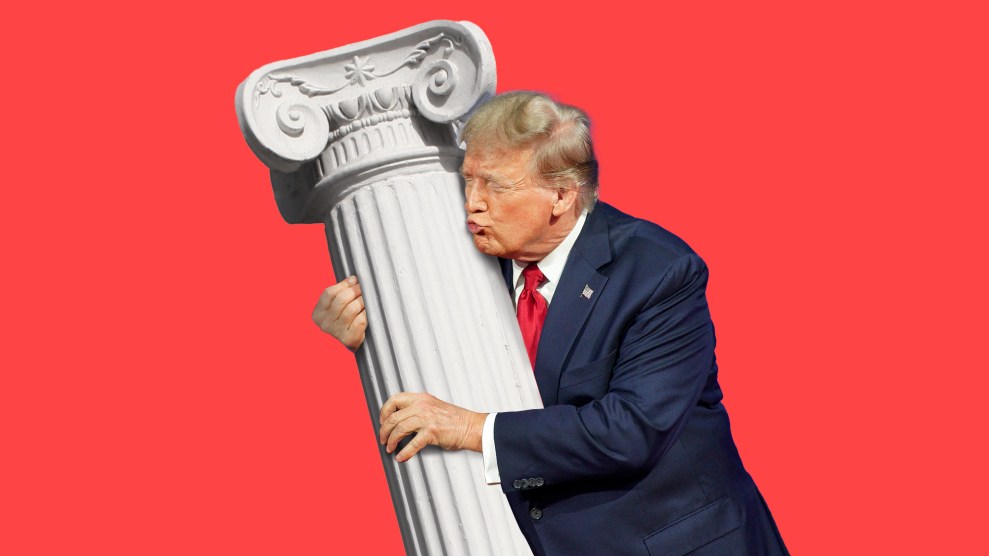
Mother Jones; Yuri Gripas/Abaca/Zuma; Getty
When I first skimmed through the Republican Party’s 2024 policy platform, a 16-page document titled “MAKE AMERICA GREAT AGAIN!,” much of it read as Trumpian but unsurprising. The platform, which is sprinkled with odd capitalization and an unusually high number of exclamation points, calls for launching the “largest deportation program in American history,” stopping “woke” government, and ending “market-distorting restrictions” on oil, natural gas, and coal. Though I hardly expected them to be, the terms “climate change,” “global warming,” or “the environment” aren’t mentioned.
But there was one section that stood out to me. In a chapter titled, “Bring Common Sense to Government and Renew the Pillars of American Civilization,” the plan calls for the restoration of “American Beauty”:
Republicans will promote beauty in Public Architecture and preserve our Natural Treasures. We will build cherished symbols of our Nation, and restore genuine Conservation efforts.
That was it. No elaboration. This, to me, is weird. What, specifically, are “our National Treasures?” What does it mean to restore “genuine” conservation efforts? And what is “beauty” in public architecture? As CNN quipped in its recent annotation of the party’s platform, “It’s not clear when or how Republicans feel American beauty ended, but they clearly want to restore it.” Of all things to rally behind, are Republicans calling for…prettier buildings?
Clues from Trump’s time in office point to yes, actually. In a December 21, 2020, executive order, then-President Donald Trump praised Greek and Roman architecture for being designed to “beautify public spaces and inspire civic pride.” Similarly, classical-style buildings like the Lincoln Memorial, Capitol Building, Supreme Court, and White House, Trump remarked, “have become iconic symbols of our system of government.”
But by the 1950s and 60s, Trump wrote, government buildings became “undistinguished” and were seen as “unappealing,” tarnished by a Brutalist design aesthetic. He bashed San Francisco’s Federal Building as being designed only for architects to appreciate. When the building opened in 2007, San Francisco Chronicle urban design critic John King praised its eco-friendly design, including natural ventilation, writing that it was “architecture at its provocative best.” Trump said residents saw it as “one of the ugliest structures in their city.” (I used to live in San Francisco. I don’t disagree.) To remedy such travesties, Trump directed his administration to embrace classical and traditional architecture that would “uplift and beautify public spaces, inspire the human spirit, ennoble the United States, and command respect from the general public.” So the GOP’s call to renew the “pillars of American civilization,” might literally mean building more pillars.
“Beauty” doesn’t exist in a vacuum.
But as some academics noted at the time, the use of classical architecture in the US has a fraught history. Reinhold Martin, an architecture professor at Columbia University, told the New York Times in 2020 that Trump’s order, while having no real teeth, was “an effort to use culture to send coded messages about white supremacy and political hegemony.” As my former colleague Camille Squires has reported, there is a long, ugly history of pro-slavery Southerners deploying classical architecture to justify their cause. “Beauty” doesn’t exist in a vacuum.
“National Treasures,” meanwhile, could mean all sorts of things. Landmarks? Historic sites? Artifacts? The joy of a human that is Dolly Parton? (Only half kidding.) Again, the Trump administration offers some hints: In an August 2020 announcement celebrating the Great American Outdoors Act, a law granting $9.5 billion for national park maintenance, the White House praised America’s national parks as “our most important national treasures.” So perhaps that’s what the GOP platform means, but I wouldn’t count on Trump to follow through on protecting them. A few months after he signed the Great American Outdoors Act, just days after losing the 2020 election, Trump’s administration moved to undermine the law.
As for “cherished symbols of our Nation” and “genuine” conservation efforts—I have no idea. Does the GOP mean Trump’s land conservation efforts (which were largely viewed as greenwashing), conservation of species, or something else? I couldn’t find any mention of these phrases in Trump administration records, and the Trump campaign has yet to respond to my request for clarification. (If they do, I’ll be sure to update this post.) Last week, at Trump’s order, delegates at the Republican National Convention passed this platform behind closed doors with almost no edits.
But perhaps the vagueness is the point. Whether intentional or not, by failing to define these terms, the Trump campaign can effectively quell the concerns of many voters who support clean air and water, land conservation, and wildlife protections, while failing to make any real commitments. Of course, without aggressive action at the highest level of government, we risk losing the natural beauty of the country as various environmental crises—climate change, biodiversity loss, ocean acidification, and more—stand to get worse. But hey, at least our buildings will look nice.
















